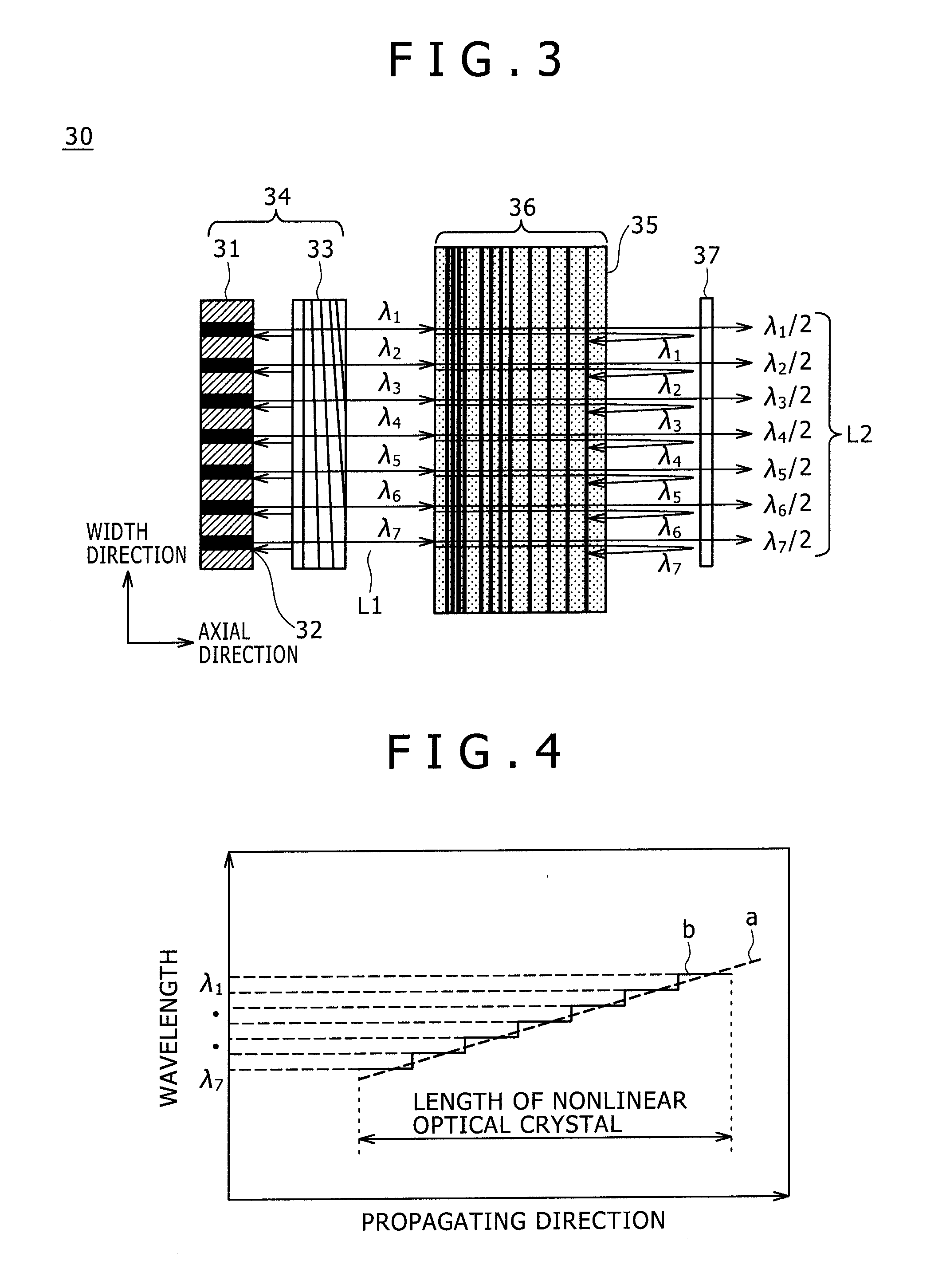Laser device, laser display apparatus, laser radiating apparatus, and nonlinear optical element
a laser display and laser technology, applied in the direction of laser details, instruments, light demodulation, etc., can solve the problems of low efficiency, limited length of poling structure effective for individual wavelengths, and inability to reduce speckle noise in turn, so as to enhance the efficiency of conversion and reduce the effect of speckle nois
- Summary
- Abstract
- Description
- Claims
- Application Information
AI Technical Summary
Benefits of technology
Problems solved by technology
Method used
Image
Examples
first embodiment
1. First Embodiment
The First Case where a Poling Period and a Poling Duty Ratio Both Change in a Propagating Direction
[0058]FIG. 1 is a schematic view showing a structure of a laser device according to a first embodiment of the present invention. As shown in FIG. 1, the laser device 10 includes a fundamental wave generating portion 14 composed of a semiconductor laser 11 composed of a laser array having a plurality of luminous points 12, and a Bragg reflection structure 13. The fundamental wave generating portion 14 is structured in such a way that a plurality of fundamental waves having respective wavelengths which are different from each other in at least one set thereof are generated. In addition, a nonlinear optical element 15 is disposed in a direction along which a plurality of fundamental waves L1 are emitted from the fundamental wave generating portion 14. A poling structure 16 adapted to pseudophase matching for the wavelengths of the fundamental waves L1 is formed along re...
second embodiment
2. Second Embodiment
The Second Case where the Poling Period and the Poling Duty Ratio Change in the Propagating Direction
[0080]FIG. 3 is a schematic view showing a structure of a laser light source device 30 according to a second embodiment of the present invention.
[0081]In the laser device 30, a fundamental wave generating portion 34 is composed of a semiconductor laser 31 composed of a semiconductor laser array or the like and having a plurality of luminous points 32, and a Bragg reflection structure 33. Also, the fundamental wave generating portion 34 generates a plurality of fundamental waves L1 having respective wavelengths λ1, λ2, . . . λ7 which are different from each other in at least one set thereof. In addition, a nonlinear optical element 35 having a poling structure 36, and a filter 37 for transmitting the harmonics and reflecting the fundamental waves are disposed in a traveling direction of the fundamental waves L1 generated.
[0082]The nonlinear optical element 35 in th...
third embodiment
3. Third Embodiment
The Case where the Poling Period Changes in the Propagating Direction and in the Laser Array Arrangement Direction
[0093]FIG. 7 is a schematic view showing a structure of a laser device 40 according to a third embodiment of the present invention.
[0094]The laser device 40 includes a fundamental wave generating portion 44 composed of a semiconductor laser array 41 and a Bragg reflection structure 43. In this case, the semiconductor laser array 41 has a plurality of luminous points 42. Also, the Bragg reflection structure 43 stabilizes the laser beams emitted from the semiconductor laser array 41 into a plurality of fundamental waves L1 having respective wavelengths λ1, λ2, . . . , λ7 which are different from each other in at least one set thereof. In addition, the laser device 40 includes a nonlinear optical element 45 and a filter 47. In this case, the nonlinear optical element 45 has a poling structure 46 meeting the pseudophase matching condition for a plurality o...
PUM
 Login to View More
Login to View More Abstract
Description
Claims
Application Information
 Login to View More
Login to View More - R&D
- Intellectual Property
- Life Sciences
- Materials
- Tech Scout
- Unparalleled Data Quality
- Higher Quality Content
- 60% Fewer Hallucinations
Browse by: Latest US Patents, China's latest patents, Technical Efficacy Thesaurus, Application Domain, Technology Topic, Popular Technical Reports.
© 2025 PatSnap. All rights reserved.Legal|Privacy policy|Modern Slavery Act Transparency Statement|Sitemap|About US| Contact US: help@patsnap.com



